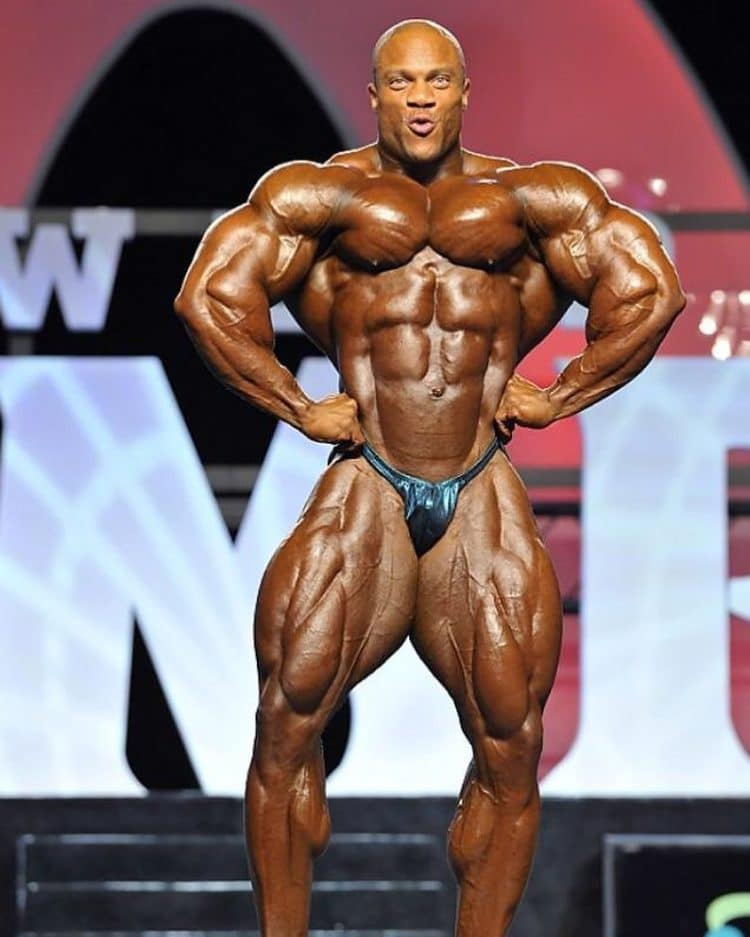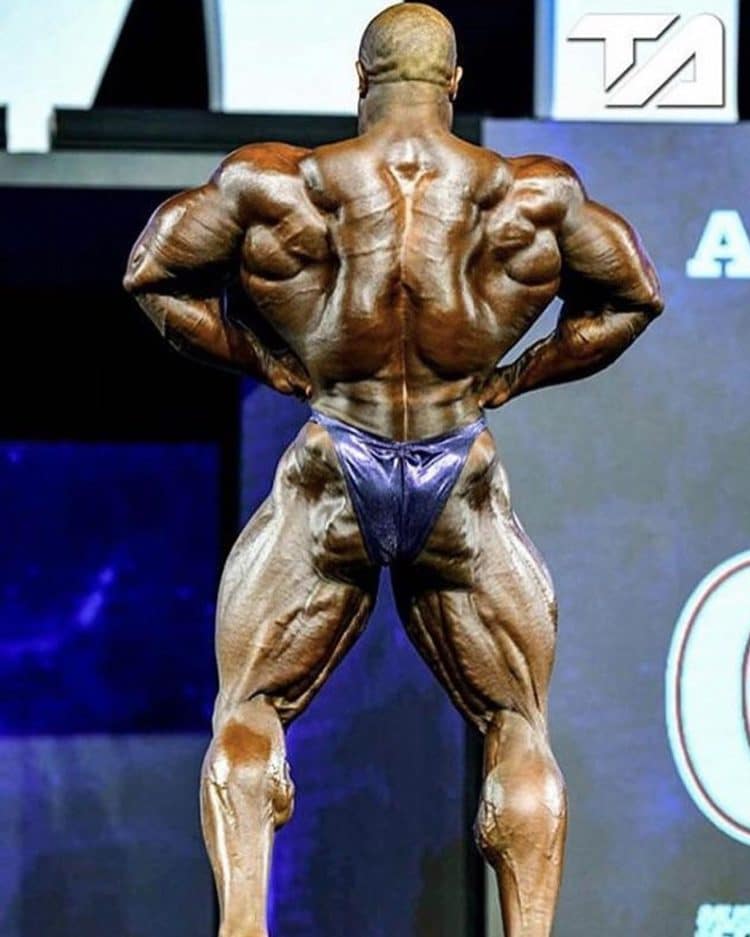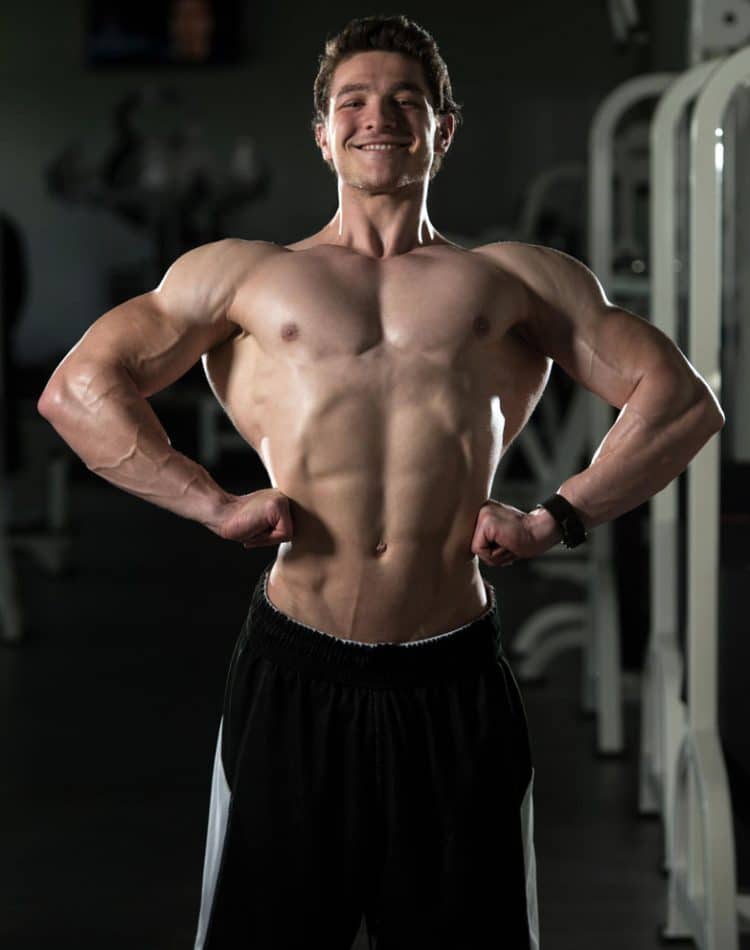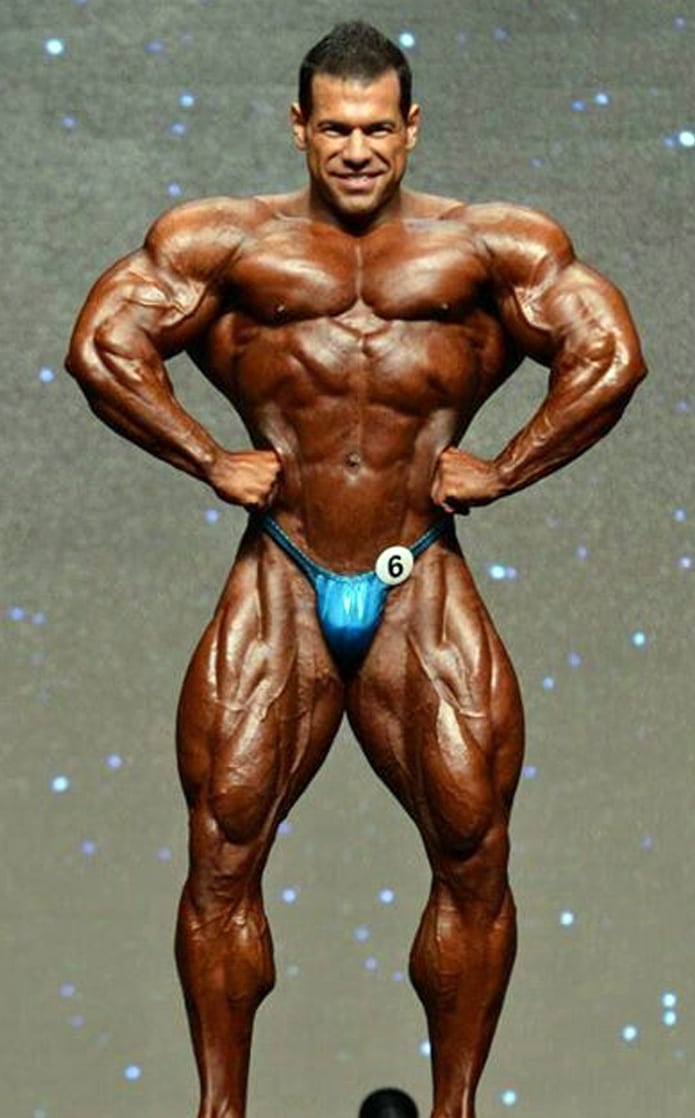The lat spread, a key bodybuilding pose, showcases the lats’ width and density, emphasizing the large muscles extending down each side of the back.
An old bodybuilding adage proclaims that bodybuilding shows are won from the back.
The lat spread is your ticket to claiming the winner’s check in a bodybuilding show.
But why is back development so important, you ask?
Since the back is not a mirror muscle, you can’t look at it in the mirror while training. It makes it incredibly difficult to establish a mind-muscle connection with it, often leading to suboptimal hypertrophy results.
Not only does the lat spread pose bring out the details in your back during a bodybuilding competition, but it can also improve your mind-muscle connection during a workout.
Level Up Your Fitness: Join our 💪 strong community in Fitness Volt Newsletter. Get daily inspiration, expert-backed workouts, nutrition tips, the latest in strength sports, and the support you need to reach your goals. Subscribe for free!
Pro bodybuilders like Arnold Schwarzenegger, Phil Health, and Chris Bumstead practice the lat spread pose during their back workouts to achieve maximal muscle stimulation.
I have my personal training clients practice this posing-during-training principle. This technique consistently leads to an immediate improvement in their muscle connection and enhanced muscle pumps.
In this article, we delve into everything you need to master the lat spread, including step-by-step instructions, advanced techniques, common mistakes and challenges, and the best exercises to develop a wide and thick back to improve the lat spread.
Detailed Guide To Perform the Lat Spread (Front and Back)

Professional bodybuilders are judged on eight mandatory poses, two of which are the front and the back lat spread.
Latissmus dorsi, popularly known as the lats, is the biggest back muscle. The lat spread pose is meant to showcase the width and thickness of the lats.
Mastering the lat spread poses requires practice and persistence. Furthermore, beginners will find engaging and spreading their lats slightly more challenging.
Here are the step-by-step instructions for performing the front and back lat spread:
Front Lat Spread

This pose is performed with your face toward the judges (or the mirror). This is how to hit it like a pro:
Step One — Take Your Position
Position your feet shoulder-width apart and turn them out slightly. Place your hands a little higher than the hip level.
Contract your legs to bring out the definition in your quads and glutes.
Pro Tip: Bodybuilders with a lagging lower body can stand with a slightly wider than shoulder-width stance to make their legs look bigger.
Step Two — Get Your Torso into Position
Exhale sharply and brace your core. Push your chest out, pull your shoulder blades back and down, and lean back slightly. Contract your lats as hard as possible during this step.
Pinch the sides of your waist between your thumbs and your index fingers.
The exact hand placement can vary depending on your body structure and genetics. People with shorter torsos and whose lats originate lower should place their hands on the top of the hips to ensure maximum lat visibility.
Pro Tip: Although I’ve laid out hitting the lat spread pose in steps, you must simultaneously move the upper and lower body. Transition between these steps smoothly to make the pose look flawless.
Step Three — Spread Your Lats
Maintaining the tension in the lats, spread your lats by pushing your shoulder blades out and spreading your lats as wide as possible while flaring your elbows.
During this step, return to the upright torso position and squeeze your chest, abs, and arms for peak contraction.
Pro Tip: Regardless of whether you’re hitting the lat spread, double bicep, or side chest pose, you must contract every muscle visible to the judges.
Back Lat Spread

The back lat spread pose is a little more technical. Here’s how to do it to impress the judges or your gym crush:
Step One — Turn Around and Plant Your Feet
Stand with your back toward the judges or the camera.
Take a staggered stance and raise the rear leg’s heel off the floor. Maintain slight flexion in the front and the back knee. Tense your lower body by contracting your calves, hamstrings, and glutes.
Remember, don’t take too big of a step back. Keep your feet close to achieve optimal lower body muscle contraction.
Pro Tip: Aim for a shoulder-wide stance and rotate your feet outward to display your glutes, hamstrings, and quad sweep.
Step Two — Get Your Torso Into Position
Pinch your waist between your thumbs and index fingers at a suitable spot on your torso.
Take a deep breath, draw your shoulder blades down and back, and pull your elbows together behind your back.
Pro Tip: Push your chest out during this step to reveal the erector spinae definition (Christmas tree).
Step Three — Spread Your Lats
Breathe out and contract your core as you spread your lats by flaring your shoulders and elbows. Lean back slightly toward the judges to reveal the size and depth in the lats, rear delts, traps, rhomboids, and teres major and minor.
Pro Tip: Rounding your chest while holding the peak contraction will help reveal additional definition, depth, and width in your back.
Lean back during this pose only if you are on a stage and not at the judges’ eye level.
Advanced Techniques and Tips for a Professional-Level Lat Spread
Posing is hard. You shouldn’t expect to master bodybuilding poses on your first day. If done correctly, a 30-minute posing session can be as exhausting as a 30-minute high-volume back workout.
As a personal trainer, I have my clients internalize these four tips to look like a pro while hitting the lat spread poses:
Keep Your Midline Tight
There is a lot happening at the same time during posing.
Many people get caught up in moving their arms and contracting their lower and upper body while hitting a lat spread and completely forget about their waist.
To look your best during the lat spread poses, you must pull in and contract your abs and obliques to give the illusion of the coveted X-frame — wide shoulders, a tiny waist, and sprawling quad sweeps.
Letting your gut hang during the lat spread pose can negatively affect your physique aesthetics.

Relaxed Front Lat Spread Pose
People who find the front and back lat spread pose too challenging can start with the relaxed front lat spread variation.
This pose involves keeping your hands on the top of your thighs instead of your waist. Although this pose is not as appealing as the conventional front lat spread pose, it allows you to contract your lats better and is an incredibly effective progression pose.
To hit the relaxed front lat spread pose, stand with your hands on the top of your thighs so your fingers are pointing toward the floor.
Spread your lats as wide as possible by flaring your elbows, arching your upper back, and pushing your chest forward.
The close elbow position will help you achieve better lat contraction. However, this pose doesn’t result in as wide of a lat spread as the conventional front and back lat spread poses.
Improve Shoulder Mobility and Flexibility
Lats originate on the lower three or four ribs, lower six thoracic vertebrae, and iliac crest (the top border of the pelvis) and insert on the humerus (upper-arm bone) just below the shoulder joint.
Shoulders play a crucial role in hitting the lat spread pose. People who lack shoulder mobility will find it difficult to activate and spread their lats optimally.
I have my clients perform a series of dynamics and static shoulder stretches before a posing session to ensure optimal mobility.
Production Value
A bodybuilder must know how to showcase their physique on the stage to win a bodybuilding show.
Arnie, Kai Greene, Franco Columbu, and Flex Wheeler were all master posers in their prime and redefined posing every time they stepped on stage. You must do the same if you want to excel as a pro bodybuilder.
Level Up Your Fitness: Join our 💪 strong community in Fitness Volt Newsletter. Get daily inspiration, expert-backed workouts, nutrition tips, the latest in strength sports, and the support you need to reach your goals. Subscribe for free!
Lightning and Tan
Since we are talking about a professional-level lat spread, we must address posing on stage.
Bodybuilders must spend some time on the stage before a show commences to check the light placement. The angle of the lights can make a big difference in how you look on the stage.
You must always pose toward the light to ensure your muscle definition, separation, conditioning, and width pops.
Plus, you must always opt for a darker tan as it can enhance muscle definition and ensure you don’t fade under harsh lights.
Common Mistakes While Hitting the Lat Spread Pose
Steer clear of these posing mistakes to stand out on the stage:
Shoulder and Elbow Positioning and Alignment
Many bodybuilders tend to skew to one side while hitting the lat spread pose, which throws their entire physique off balance.
The judges score balance and symmetry during a contest. Tilting your elbows and shoulders to one side can hamper your physique aesthetics.
During a lat spread pose, your elbows should be slightly ahead of your midline to ensure peak lat contraction and maximum width.
Avoid rolling your shoulders forward or shrugging them. Practice retracting and depressing your scapula to master peak lat contractions.
Rounding the Chest in the Front Lat Spread Pose
This is one of the most common mistakes while performing the front lat spread.
Bodybuilders tend to roll their shoulders and hunch their backs in hopes of achieving greater width. However, this compresses the lats and makes them appear smaller.
Focus on pushing out your chest while flaring your shoulder blades and elbows. It will help you maintain an upright torso while displaying full back width.
Breathing
Breathing is one of the most overlooked aspects of posing.
Controlled breathing during posing separates the pros from the amateurs.
Many beginners breathe in and hold their breath while they strike a pose. However, this extends the belly, which can throw off the physique balance and symmetry.
Breathe out and contract your abs as you hit a pose to ensure tightness throughout the body.

Not Contracting Other Muscle Groups
Many newbies skip contracting their lower body while hitting the upper body poses like the front lat spread and front double biceps.
When posing, you must contract all the muscles facing the judges.
The lat spread is not just about showcasing the back but also about showcasing a symmetrical, well-balanced muscular physique. Engaging all the other muscle groups helps create a more defined and aesthetic look.
Pro Tip: Practice engaging each muscle group independently to achieve optimal contraction while hitting a bodybuilding pose.
I recommend my clients focus on contracting a specific muscle group during a workout. Fully body posing is reserved for after the workout.
Importance of Lat Spread in Bodybuilding
Learning how to pose is non-negotiable for competitive bodybuilders. Furthermore, posing can help develop your overall physique aesthetics by improving the mind-muscle connection.
A Mandatory Pose in Three Divisions — Role in Competition
The front and back lat spreads are a mandatory pose in three divisions of the IFBB Pro League — the world’s biggest professional bodybuilding organization. These include the Men’s Open, 212, and Women’s Open divisions.
Other divisions like the Classic Physique, Wheelchair, and Women’s Physique comprise the front and back double biceps pose, which involves many of the same posing principles.
Furthermore, Men’s Physique, Figure, and Fitness divisions require the athletes to perform quarter turns, which involve a toned-down version of the lat spread.
Judges closely evaluate the lat spread for several aspects: the width of the lats, the symmetry between the left and right sides, the definition and separation of the muscles, and the overall balance with other muscle groups.
V-Taper
To stand out while hitting the lat spread pose, you must focus on your lat development. Building thick and wide lats is crucial for a pronounced V-taper.
A V-taper adds to the illusion of broad shoulders, a wide chest, and a narrow waist. It makes bodybuilders look bigger and wider than they actually are.
Every time a bodybuilder hits the lat spread, they should look like a cobra spreading their hood.
Practicing the lat spread is one of the best ways to sculpt a picture-perfect back. Additionally, targeted back exercises enhance mind-muscle connection, improving the ability to engage and grow the lats.
Common Challenges in Mastering the Lat Spread
As a personal trainer, I’ve identified two primary hurdles that lifters encounter while hitting the lat spread pose:
Difficulty in Activating and Feeling the Lats
Many people, especially beginners, find activating their lats during this pose difficult due to a lack of mind-muscle connection. It leads to an overreliance on arm and shoulder movement during the pose, which can further deteriorate lat stimulation.
Solution: Incorporating isolation exercises like straight-arm lat pulldowns and dumbbell pullovers in your training regimen can improve lat activation during training and posing. Focus on muscle contraction and stretch during these exercises to strengthen lat activation.
Visual and Physical Challenges
Most people have a dominant side, which can lead to muscle imbalances. An uneven muscle development can lead to an asymmetrical lat spread pose.
Solution: Addressing this issue involves a two-pronged approach. Adding unilateral exercises to your training regimen is one of the best ways to fix muscle and strength imbalances. Second, you must spend time working on the pose itself. Get in front of a mirror and start posing until you’re happy with the outcome.
Furthermore, you can record your posing sessions and send them to a qualified trainer for evaluation. Work on the feedback until you’re hitting the lat spread pose like a Mr. Olympia champion.
Exercises to Strengthen and Develop Lats for an Effective Spread
To build wide and thick lats, you must add two types of exercises to your training regimen. Exercises with a vertical and horizontal line of resistance. The former biases the lat width, whereas the latter improves back thickness.
Here are the exercises that must be a part of your lat-building routine:
Lat Pulldown
A randomized controlled trial published in the Journal of Strength and Conditioning Research found that a pronated grip activates the latissimus dorsi more effectively than a supinated grip, regardless of the grip width. (1)
Plus, a comparative study analyzing the three different types of lat pull-down concluded that the front-of-the-neck technique was more effective for lats’ activation than behind-the-neck and V-bar techniques (2).
How To:
- Choose an appropriate weight on the lat pulldown machine.
- Grab the handlebar with a wider than shoulder-width overhand grip.
- Sit on the machine and slide your legs under the thigh pad.
- Keeping your torso upright, pull the bar to your neck level while driving through your elbows.
- Pause and squeeze your lats at the bottom.
- Slowly return to the start position.
- Repeat for recommended reps.
Pro Tip: Keep your elbows tight to your side on concentrics and contract your lats at the bottom. Think of the isometric contraction point as the moment just before you flare out your lats in the lat spread pose.
Single-Arm Dumbbell Row
The one-arm dumbbell row is an excellent unilateral exercise to fix muscle imbalances.
I have my clients use slow eccentrics to establish a better mind-muscle connection. A review published in the British Journal of Sports Medicine found that “Eccentric training performed at high intensities was more effective in promoting increases in muscle mass measured as muscle girth.” (3)
How To:
- Hold a dumbbell in your right hand with a neutral grip (palm facing your body).
- Take a staggered stance in front of a dumbbell rack and place your left hand on the rack.
- Hinge at your hips so your torso is almost at 45 degrees. Maintain slight knee flexion.
- Pull the dumbbell to your side by driving your elbow toward the ceiling.
- Pause and contract your lat at the top.
- Slowly return to the starting position.
- Repeat for recommended reps before switching slides.
Pro Tip: Perform two to three additional reps on the lagging side to fix muscle imbalances. You must evaluate your progress each week to ensure you don’t overdo training on the weaker side.
Seated Cable Row
The seated cable row is among the most popular back exercises for building back width and girth.
The cult bodybuilding documentary Pumping Iron (1977) shows Arnold Schwarzenegger performing this exercise during a grueling back workout. Although many people have since questioned his form on this exercise, none have ever challenged the effectiveness of the exercise itself.
You’re leaving gains on the table if you’re not performing the seated cable row in your back workout.
How To:
- Pin an appropriate weight on the cable row machine so that you can perform 8-12 reps with a picture-perfect form.
- Attach a V-handle bar to the pulley.
- Grab the handle and sit on the machine.
- Your torso should be upright, and the cable should be taut at the starting position.
- Slowly bring the handle toward the pulley until you feel a deep stretch in your lats.
- Feel free to readjust your sitting position if the weights restack before you can feel your lats fire up at the bottom of the ROM.
- Initiate the concentric phase by leaning back. Simultaneously, drive your elbows behind your midline.
- Your torso should be at 90 degrees, and your elbows behind your midline at the isometric contraction point.
- Slowly return to the starting position.
- Repeat for reps.
Pro Tip: The stretch at the bottom of the range of motion in the seated cable row can help you hold the muscle contraction during a pose for longer. Pause at the bottom to increase the time under tension and boost muscle stimulation.
Conclusion
Learning and practicing the lat spread pose can be a game changer for folks trying to build a back as wide as a barn door. It improves the mind-muscle connection, which can help create a more sculpted and aesthetically appealing physique.
You must perform the lat spread pose while resting between sets. Post-workout, perform all eight mandatory bodybuilding poses to improve muscle activation and growth.
If you have any questions about the lat spread pose, drop them in the comments below, and I’ll be happy to help!
References
- Lusk SJ, Hale BD, Russell DM. Grip width and forearm orientation effects on muscle activity during the lat pull-down. J Strength Cond Res. 2010 Jul;24(7):1895-900. doi: 10.1519/JSC.0b013e3181ddb0ab. PMID: 20543740.
- Sperandei S, Barros MA, Silveira-Júnior PC, Oliveira CG. Electromyographic analysis of three different types of lat pull-down. J Strength Cond Res. 2009 Oct;23(7):2033-8. doi: 10.1519/JSC.0b013e3181b8d30a. PMID: 19855327.
- Roig M, O’Brien K, Kirk G, Murray R, McKinnon P, Shadgan B, Reid WD. The effects of eccentric versus concentric resistance training on muscle strength and mass in healthy adults: a systematic review with meta-analysis. Br J Sports Med. 2009 Aug;43(8):556-68. doi: 10.1136/bjsm.2008.051417. Epub 2008 Nov 3. PMID: 18981046.
Article Updates Timeline:
Our editorial team experts constantly update the articles with new information & research, ensuring you always have access to the latest and most reliable information.
January 6, 2024
Written By
Vidur Saini
Reviewed By
Editorial Team








